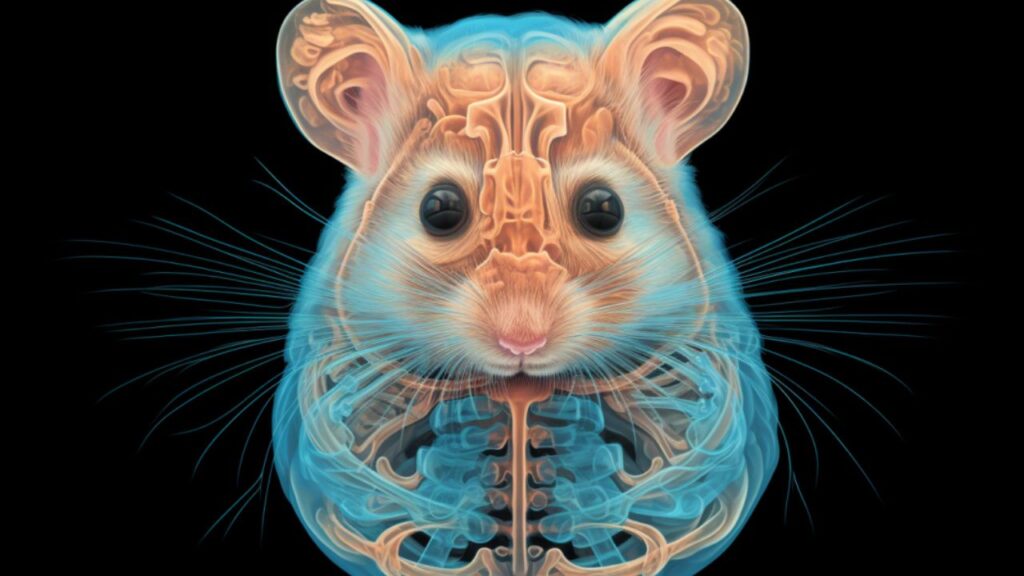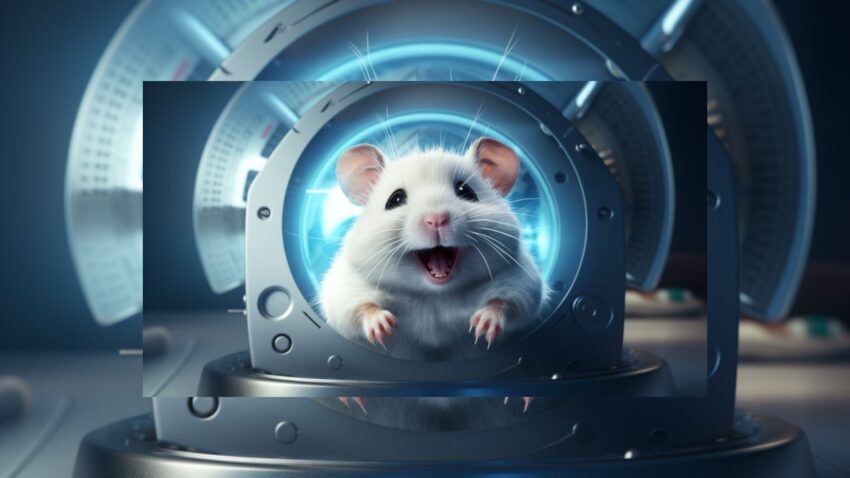TL;DR Summary
Yes, hamsters have brains. Though small, their brains are mighty, managing essential bodily functions and complex behaviors. A hamster’s brain is responsible for survival instincts, daily activities, and intricate actions like nesting and hoarding. Cognitive abilities in hamsters are evident in their learning, memory, and problem-solving skills, comparable to other rodents of similar size. To support their cognitive health, providing a stimulating environment, a nutritious diet, and interactive activities are crucial. With proper care, hamsters can exhibit a range of intelligent behaviors and live contentedly. Remember, a happy hamster is a wheel-y happy you!
Amidst the myriad queries that intrigue the minds of hamster enthusiasts and pet owners alike, there lies a fundamental question: Do hamsters have brains? It’s a query that may tickle the fancy of the curious and the scholarly. To set the record unequivocally straight — yes, hamsters, much like every member of the mammalian kingdom, are equipped with brains. This central organ is not simply an anatomical feature but the very seat of their living essence.
The Hamster’s Neural Command Center: Brain Function and Complex Vitality
Embarking on a journey into the hamster’s cranium reveals a neural command center, deceptively powerful for its modest size. The brain of a hamster is a bustling metropolis of activity, where neurons fire and networks connect to oversee the critical functions that bolster the hamster’s energetic existence. This central hub is where the intricate dance of life-sustaining operations is choreographed, each physiological process fine-tuned to the rhythm of survival and instinct.
From the delicate regulation of their circadian rhythms, ensuring that each hamster adheres to its nocturnal essence, to the precise modulation of bodily functions, every aspect of their existence is guided by this neural nucleus. Sensory inputs are decoded here, informing the hamster’s interactions with the ever-changing tapestry of their environment, guiding them through the complexities of their miniature world with the precision of a master conductor.
The Brain’s Influence on Hamster Behavior and Emotion
Venture further into the cerebral realm, and one discovers the core of the hamster’s behavioral and emotional tapestry. It is within these neural confines that emotions such as anxiety and tranquility are balanced, painting the emotional landscape in which a hamster thrives. The brain serves as the repository of the hamster’s memories, a living archive where lessons from exploratory ventures are etched into the fabric of their being.
This neural sanctum is also the architect of intricate behaviors, from the artistry of nest construction to the strategic cache of food reserves, each action not merely a play of instinct but a reflection of a learned symphony, an adaption to the hamster’s personal narrative and environmental dialogue. Thus, the hamster brain, though limited in size, emerges as a monumental force, a beacon of biological sophistication that empowers these creatures to navigate their existence with an exuberance that defies their physical limitations.
In essence, the hamster’s brain encapsulates a microcosm of life, a potent symbol of the extraordinary feats small beings are capable of. It is the essence of their vitality, propelling the multitude of functions and behaviors that render hamsters not merely as pets but as tiny, enigmatic companions whose cognitive abilities command our respect and wonder. It stands as a testament to the notion that within even the smallest of beings, there exists a world of profound complexity and awe-inspiring capability.
Anatomy of a Hamster’s Brain

The anatomy of a hamster’s brain is a subject of profound intricacy and fascination, a topic that beckons with as much charm as the creatures themselves. Dwelling within the confines of their diminutive skulls, the hamster’s brain is an organ of remarkable complexity and capability. Let’s delve into the physicality and functionality of this vital organ, revealing the mystery of what powers the engaging behaviors and physiological processes of these beloved rodents.
The Structure and Size of the Brain
Hamsters possess a brain that is proportionate to their small stature, typically weighing only a few grams. Despite its minute size, the brain’s structure is complex, composed of all the essential parts found in larger mammalian brains, including the cerebrum, cerebellum, and brainstem. The cerebrum is involved in processing sensory information and controlling behavior, while the cerebellum regulates coordination and movement, and the brainstem handles vital involuntary functions like respiration and heartbeat.
The brain is protected by a bony structure known as the skull, and it is cushioned by layers of membranes and fluid to prevent injury. Inside, neurons form a dense network of communication pathways, with numerous connections that facilitate the transmission of electrical signals, allowing the hamster to process information and react to its environment.
The Brain’s Regulatory Functions
The hamster’s brain is the control center for its bodily functions and behaviors, dictating everything from instinctive survival reactions to complex tasks such as building a nest or navigating its habitat. It is where hormones and neurotransmitters are produced and released, influencing everything from mood to metabolism.
This small but mighty organ is also responsible for the regulation of circadian rhythms, telling the hamster when it’s time to be active and when to rest. It oversees the intricate balance of homeostasis, maintaining the internal environment in a state conducive to life. Moreover, the brain enables hamsters to perform a variety of behaviors that are crucial for their survival, including foraging for food, avoiding predators, and social interactions with other hamsters.
In summary, the hamster’s brain may be small when compared to that of larger animals, but it is a microcosm of neural activity that supports an array of complex life-sustaining functions. It is a testament to the evolutionary ingenuity of nature, showcasing that size does not necessarily dictate capability when it comes to the intricate workings of the mammalian brain.
The Brain’s Role in Hamster Behavior

Venturing into the realm of hamster behaviors reveals a rich landscape painted by the intricate brushstrokes of their cerebral functions. The hamster’s brain, though small, is an epicenter of bustling neural activity that governs a wide array of behaviors, from the primal instincts required for survival to the elaborate rituals that punctuate their daily lives.
Instincts and Innate Behaviors
At the core of a hamster’s existence, survival instincts are deeply etched into the folds of their brain. It is this neural fabric that sparks the lightning-fast reactions to perceived threats, the innate ability to navigate their environment, and the compulsion to seek sustenance. These instincts are not learned but rather hardwired into the hamster’s brain, allowing for instantaneous and often life-saving responses to the world around them.
Daily Activities and Rhythms
The hamster’s brain is also the conductor of their daily activities. It regulates sleep cycles, ensuring that they adhere to their nocturnal nature, orchestrating the precise timing of activity during the darker hours when they are naturally more secure from predators. This neural command center cues the hamster when to eat, groom, exercise, and explore, maintaining a delicate balance between activity and rest.
Complex Social and Solitary Behaviors
Moreover, the brain is the architect behind more complex behaviors such as nesting and hoarding. Nesting is a behavior driven by the brain’s interpretation of environmental cues, compelling the hamster to create a safe and comfortable haven for rest and, potentially, the raising of young. The intricate process of creating a nest from various materials is a testament to the brain’s ability to process information and translate it into physical action.
Hoarding is another sophisticated behavior, rooted in the hamster’s evolutionary history. In the wild, food scarcity is a constant threat, and the brain has adapted to this challenge by compelling the hamster to collect and store food. This behavior ensures a supply of sustenance even when external resources are sparse. The brain manages these stores, remembering the locations of caches and monitoring the quality of hoarded items.
Behavioral Adaptations and Learning
The hamster’s brain is not only a repository of instincts and hardwired behaviors but also a dynamic organ capable of learning and adaptation. Through experiences, the brain adjusts behaviors, refines techniques, and can even develop new strategies for interacting with its environment and fellow hamsters. This capacity for adaptation speaks to the brain’s role not just as a driver of innate behaviors but as a malleable entity, capable of change and growth.
The hamster’s brain, in all its minute glory, is a complex command system that intricately weaves the tapestry of their behavior, ensuring survival, facilitating daily life, and enabling a suite of behaviors that are both fascinating and essential to the hamster’s well-being.
Cognitive Abilities of Hamsters

The cognitive landscape of hamsters is a field ripe with discovery, where research and careful observation continue to reveal the depth and agility of these small creatures’ mental capabilities. Far from being simple beings, hamsters exhibit a range of cognitive functions, from learning and memory to problem-solving, which allows them to navigate their world in sophisticated ways.
Learning and Memory
Hamsters possess the ability to learn and retain information, a key aspect of their cognitive prowess. Studies have shown that hamsters can learn to navigate mazes, indicating not only spatial awareness but also the capacity for recall. They can remember the locations of food sources and the pathways to their nests, which are crucial skills in the wild where remembering the location of resources can mean the difference between life and starvation.
Their learning is also evident in the way they can adapt to routines and new environments. Hamsters can recognize their caregivers and respond to conditioning, such as associating certain sounds or actions with feeding times, showing that they have a capacity for associative learning.
Problem-Solving Skills
Problem-solving is another facet of the hamster’s cognitive skill set. When presented with challenges, such as accessing a treat or navigating towards a desired destination, hamsters can demonstrate a remarkable level of ingenuity. They can use objects in their environment to aid in their tasks, manipulate their cage features to their advantage, and even learn from trial and error.
Social Cognition
Hamsters also display elements of social cognition. While they are often solitary animals, when interacting with others, whether it’s humans or other hamsters, they exhibit a level of social understanding. They can recognize and differentiate between individuals, and react differently based on past interactions. This level of social cognition is indicative of a complex neural processing capability that extends beyond basic survival instincts.
The Role of Play
Play behavior in hamsters can also be a window into their cognitive abilities. Through play, young hamsters learn about their environment, test boundaries, develop motor skills, and learn the social cues of their species. Engaging in play is not only a physical activity but also a mental exercise that contributes to cognitive development.
The cognitive world of hamsters is nuanced and capable of more than meets the eye. These capabilities enable hamsters to engage with their environment and their human companions in meaningful ways, displaying a depth of intelligence that ensures their survival and enriches their interactions. Research into hamster cognition continues to unfold, promising further insights into the mental lives of these intriguing animals.
Whisker Tips

In the realm of hamster care, cognitive enrichment stands as a pillar of utmost importance. The stimulation of a hamster’s brain through environmental enrichment and diet plays a crucial role in maintaining their mental agility and overall well-being. In our “Whisker Tips” section, we offer a selection of strategies designed to engage your hamster’s mind, ensuring a fulfilling and vibrant life.
Enriching the Hamster’s Environment
- Varied Habitats: Create a habitat for your hamster that’s rich in opportunities for exploration. Add tunnels, platforms, and hideaways to mimic the complexity of their natural environment and encourage physical and mental activity.
- Rotating Toys: Regularly introduce new toys and rotate existing ones to keep your hamster’s environment novel and stimulating. Puzzle toys that require manipulation to release treats can be particularly engaging.
- Foraging Fun: Mimic the natural foraging behavior by hiding food in different parts of the cage or using foraging toys. This encourages natural behaviors and provides mental stimulation.
- Safe Climbing Structures: Incorporate climbing structures that are safe for hamsters to use. Climbing is not only excellent physical exercise but also a mental challenge.
Diet for Cognitive Health
- Nutrient-Rich Foods: Offer a balanced diet that includes a variety of nutrients known to support brain health. Foods rich in omega-3 fatty acids, such as flax seeds, can be beneficial in moderation.
- Fresh Foods: Introduce fresh fruits and vegetables to provide vitamins and antioxidants. However, always introduce new foods gradually and in small quantities to avoid digestive issues.
- Chewable Items: Provide chew sticks or untreated wood blocks to keep your hamster’s teeth healthy and their minds engaged.
Activities to Promote Cognitive Health
- Interactive Playtime: Spend time each day interacting with your hamster. Handling and gentle play can stimulate their minds and strengthen the bond between pet and owner.
- Training Sessions: Hamsters can learn simple tricks or commands, which can be a fun way to engage their cognitive abilities. Use positive reinforcement and patience during these sessions.
- Changing Scenery: Allow your hamster time outside the cage in a hamster-proofed area under supervision. This change of scenery can provide new stimuli and enrichment.
By incorporating these “Whisker Tips” into your hamster care routine, you can provide a stimulating environment that nurtures the cognitive health of your furry companion. Engaging your hamster’s brain is not just about entertainment; it’s about enriching their lives and fostering a deep sense of curiosity and vitality. Remember, a happy hamster is a wheel-y happy you!
Conclusion

As we draw the curtains on our foray into the fascinating cognitive world of hamsters, we reflect upon the insights gathered about these remarkable creatures. From the intricate structure of their tiny brains to the complex behaviors these brains govern, hamsters prove to be as intellectually endowed as they are endearing.
Reflection on the Hamster’s Cognitive Journey
We’ve affirmed that hamsters, despite their size, boast brains that are intricate marvels of nature, orchestrating everything from basic life processes to sophisticated behaviors like hoarding and nesting. Their cognitive abilities extend to learning, memory, and problem-solving, showcasing a level of intelligence that is captivating and, at times, quite surprising.
The environment in which a hamster resides plays a significant role in their cognitive health. By providing a habitat filled with complexity and opportunities for engagement, we can encourage their natural instincts and behaviors. A varied and nutritious diet not only fuels their physical health but also supports their cognitive functions, ensuring that their minds remain as active and healthy as their bodies.
Encouraging Cognitive Enrichment
Through playful interaction and training, we can engage their minds, promote their cognitive well-being, and deepen the bond we share with our furry friends. By implementing the practical “Whisker Tips” provided, every hamster owner can become a guardian of their pet’s mental and physical health, ensuring that their little companions lead a life that is as mentally stimulating as it is physically comfortable.
As we close this chapter, let us carry forward the message that the care we bestow upon our hamsters greatly influences their quality of life. By understanding the complexity and needs of their brains, we can create an environment that truly caters to their well-being.
Remember, a happy hamster is a wheel-y happy you!




